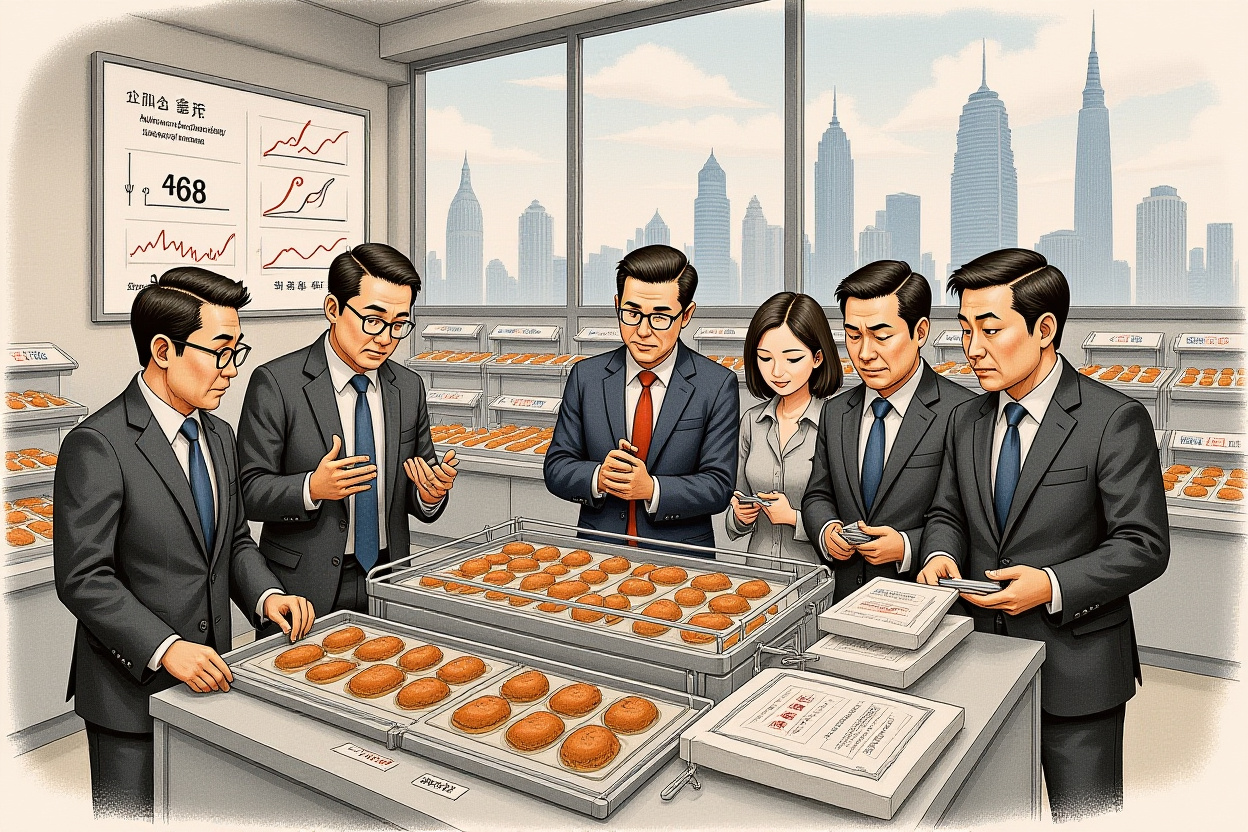Executive Summary
- Chinese regulators have officially defined pre-made food (预制菜) for the first time, excluding central kitchen operations from this category
- New labeling requirements are being piloted across multiple provinces to enhance consumer transparency
- Food safety concerns regarding additives and preservatives are being addressed through stricter regulations
- The industry continues to grow despite recent controversies, with national standards currently in development
- International investors should monitor regulatory developments that may impact Chinese restaurant chains and food manufacturers
China’s Pre-made Food Sector at Regulatory Crossroads
China’s rapidly expanding pre-made food industry faces a pivotal moment as regulatory authorities clarify definitions, address safety concerns, and implement new transparency requirements. The sector, which gained significant momentum during pandemic-related lockdowns, now confronts consumer skepticism and regulatory scrutiny that could reshape investment landscapes for food service companies and manufacturers alike.
The recent national discussion about pre-made food has pushed several major restaurant chains to revert to freshly prepared dishes in their establishments. This shift reflects growing consumer awareness and the increasing importance of transparency in China’s food service industry. For international investors tracking Chinese consumer trends, these developments signal both challenges and opportunities within the food sector.
Defining Pre-made Food: Regulatory Clarification
In March 2024, China’s State Administration for Market Regulation (国家市场监督管理总局) and five other ministries issued the ‘Notice on Strengthening Pre-made Food Safety Supervision and Promoting High-Quality Industrial Development’. This document marked the first national-level definition of pre-made food, bringing much-needed clarity to a previously ambiguous category.
What Qualifies as Pre-made Food?
The regulatory definition specifically excludes several categories that were previously grouped under the pre-made food umbrella. According to the notice, pre-made food cannot contain preservatives, does not include staple foods, and excludes ready-to-eat items like vegetable salads. Most significantly, dishes prepared in central kitchens (中央厨房) fall outside the official pre-made food classification.
Zhang Chunhui (张春晖), Chief Scientist at the Chinese Academy of Agricultural Sciences, explains: ‘The notification subtracts from the pre-made food concept, drawing boundaries between pre-made food, prepared vegetables, and central kitchen industries. This helps prevent some businesses from exploiting the pre-made food label for marketing purposes and disrupting the market.’
Consumer Versus Industry Perspectives
The regulatory clarification highlights a fundamental disconnect between industry and consumer understanding. Huang Caihua (黄才华), Director of Beijing Jinwen Law Firm, notes: ‘According to current standards, meals distributed from central kitchens do not belong to the pre-made food category. This differs from the public perception that packaged, pre-processed food constitutes pre-made food.’
Sun Juanjuan (孙娟娟), Researcher at Renmin University’s Food Safety Governance Collaborative Innovation Center, identifies the root of this认知差异 (cognitive difference): ‘Operators focus on the product itself, while consumers focus on production methods.’ This divergence in perspective continues to drive much of the controversy surrounding pre-made food in China.
Transparency Requirements: The Labeling Debate
Consumer advocacy for transparency has prompted regulatory action across multiple Chinese jurisdictions. The fundamental principle driving these changes is consumers’ right to know what they are purchasing, as established in China’s Consumer Rights Protection Law.
Regional Labeling Initiatives
Several provinces have taken proactive steps toward implementing pre-made food disclosure requirements:
- Guangdong’s ‘Cantonese Pre-made Food Packaging Labeling General Requirements’ effective April 2025 mandate clear ‘pre-made food’ or ‘pre-made dish’ labeling with ingredient percentage disclosure
- Shanghai市场监管管理局 (Market Supervision Administration) has announced pilot programs in select restaurants with plans for city-wide expansion
- Hunan Province is researching practical disclosure methods through industry self-regulation and pilot programs
Xu Guangjian (许光建), Professor at Renmin University’s School of Public Administration, observes: ‘From central to local levels, these past two years have seen increased efforts to promote pre-made food disclosure work, with many beneficial practices and explorations.’
Implementation Challenges
Despite these initiatives, practical implementation faces significant hurdles. Huang Caihua notes that while documents promote disclosure, they typically lack mandatory requirements, relying instead on restaurant自觉行为 (voluntary compliance). Many businesses worry that transparency might deter customers concerned about food quality.
A platform company representative revealed the enforcement dilemma: ‘Currently, regulatory aspects lack specific management regulations and实施细则 (detailed rules), making it impossible for platforms to restrict or强制 (force) food merchants to add labels.’ The absence of rapid testing methods further complicates regulatory oversight.
Voluntary Transparency Efforts
Some forward-thinking restaurants have embraced transparency voluntarily. Certain brands now categorize dishes as ‘restaurant freshly made,’ ‘semi-pre-made,’ or ‘reheated pre-made,’ receiving positive consumer feedback. Several chain restaurants’ ordering apps already feature labels such as ‘fresh meat and vegetable preparation’ or ‘central kitchen preparation.’
Safety Concerns: Addressing Additive Anxieties
Consumer apprehension about additives and preservatives represents a significant barrier to broader pre-made food adoption. Many Chinese consumers express concerns about long-term health effects from regularly consuming pre-made items.
Regulatory Safety Framework
According to Li Jinfei (李进飞), founder of Yuxiang Lapopo restaurant chain, the regulatory framework specifically prohibits preservatives in pre-made food. He explains: ‘Pre-made food通过冷冻、冷藏等贮存条件和杀菌处理 (through freezing, refrigeration storage conditions and sterilization treatment) eliminates the technical necessity for preservatives.’
A pre-made food enterprise负责人 (responsible person) from central China adds: ‘Pre-made food production uses physical preservation technologies like quick-freezing锁鲜 (freshness locking), inert gas packaging, and freshness cards to address most preservation needs.正规企业 (Regular enterprises) typically use food additives规范地 (standardized).’
Comparative Safety Analysis
Wang Xufeng (王旭峰), President of the Capital Health Nutrition and Food Association, emphasizes that pre-packaged foods, including pre-made dishes, must adhere to strict additive regulations regarding品种、剂量 (varieties and dosages). However, he acknowledges that some companies add flavor enhancers to cater to preferences for ‘heavy tastes,’ while others may compromise on sterilization and cold chain logistics, increasing bacterial risks.
Interestingly, freshly wok-fried dishes present their own safety concerns. Wang notes: ‘Wok frying同样存在风险 (also carries risks), such as high-temperature cooking increasing carcinogen content or insufficiently fresh ingredients producing harmful substances like nitrites.’
Luo Yunbo (罗云波), Distinguished Professor at Beijing Technology and Business University’s Food and Health College, argues that nutritional quality depends not on preparation method but on ingredient quality and standardized, hygienic processes. The debate ultimately reflects broader concerns about food safety across China’s culinary landscape.
Future Development Trajectory
Despite recent controversies, China’s pre-made food industry continues to receive policy support. The sector was first included in the Central Committee’s No. 1 document in 2023, which explicitly called for ‘cultivating and developing the pre-made food industry.’ Subsequent provincial government工作报告 (work reports) have frequently mentioned pre-made food as a development priority.
International Context and Market Potential
Xu Guangjian puts China’s pre-made food development in global perspective: ‘Markets like the United States and Japan have pre-made food penetration rates exceeding 60%. We need not regard pre-made food as a monster. The key is how to promote standardized and healthy industry development.’
This suggests significant growth potential for China’s market, which currently trails more developed markets in pre-made food adoption rates. The convenience and standardization benefits align with urbanization trends and changing consumption patterns among China’s growing middle class.
Standardization and Innovation
Experts recommend accelerating the development of unified national standards to provide comprehensive guidelines for production, transportation, and handling processes. Simultaneously, technological innovation in quick-freezing, vacuum packaging, and cold chain logistics will be crucial for improving product quality.
The China Chain Store and Franchise Association (中国连锁经营协会) has announced that national pre-made food standards led by the National Health Commission (国家卫生健康委员会) will soon seek public feedback. The association continues to cooperate on improving industry standards, particularly regarding labeling in餐饮 (food service) contexts, pushing for clearer and more operational guidance.
Regulatory Enforcement and Industry Development
Enhanced regulatory oversight will be essential for healthy industry development. Market regulatory authorities have committed to strengthening food production permit management, conducting supervision sampling and risk monitoring, and cracking down on违法违规行为 (illegal activities).
Wang Hongtao (王洪涛), Vice President of the China Chain Store and Franchise Association, emphasizes the role of education: ‘Scientific research institutions, industry associations, and other organizations should strengthen science popularization to guide consumers toward scientific understanding of pre-made food, using rational consumption choices to promote market and industry progress.’
Investment Implications and Market Outlook
The evolving regulatory landscape for China’s pre-made food industry presents both challenges and opportunities for investors. Companies that adapt quickly to new transparency requirements and safety standards may gain competitive advantages, while those slow to comply could face consumer backlash and regulatory pressure.
The clarification between central kitchen operations and pre-made food proper may create differentiation opportunities within the restaurant sector. Investors should monitor which chains successfully communicate their preparation methods to increasingly discerning consumers. Food manufacturers that supply the pre-made food sector should anticipate tighter regulations around additives and processing methods.
International investors should track the development of national standards expected later this year, as these will likely shape industry consolidation and competitive dynamics. Companies with strong technological capabilities in food preservation and logistics may particularly benefit from the industry’s continued evolution toward higher quality and safety standards.
Despite current challenges, China’s pre-made food industry remains positioned for long-term growth, driven by urbanization, rising labor costs in food service, and changing consumer lifestyles. The current regulatory scrutiny may ultimately strengthen the sector by addressing legitimate concerns and building consumer trust through transparency and safety assurances.




